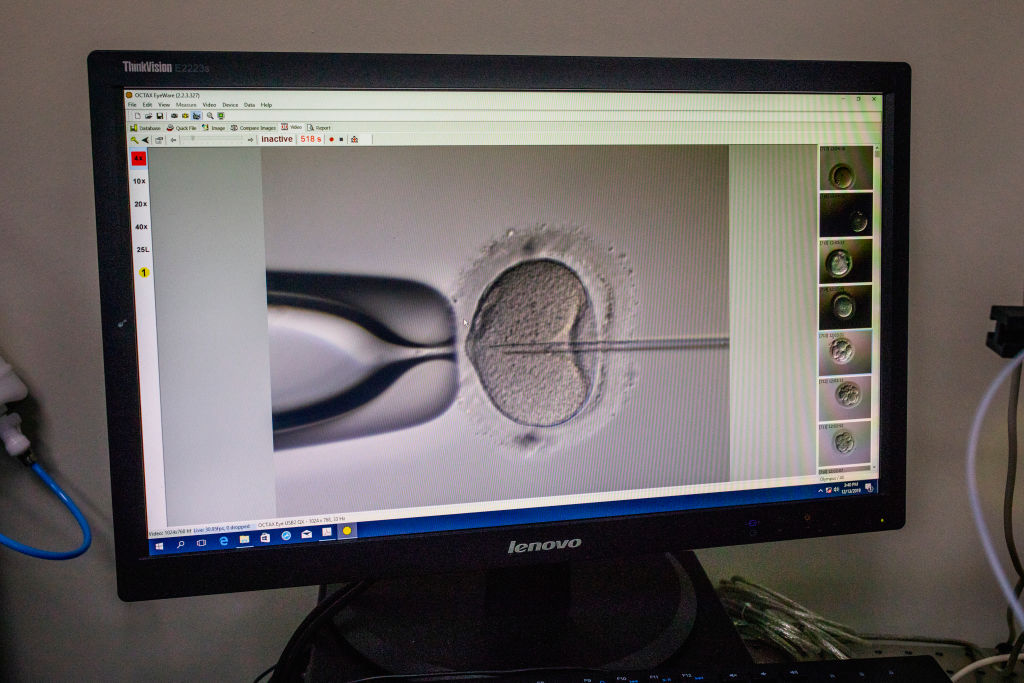“The prospective oocyte donors should be adequately counseled about the risks related to egg donation,” they said.

TBILISI, GEORGIA - 2019/12/19: At a computer screen at a lab in Tbilisi, Georgia, Doctor Jordan from Spain, is doing an artificial insemination in to an egg that later will be planted into a Georgian surrogate mother. The country of Georgia has become a hub for the international surrogate industry, driven by the poverty of domestic surrogate mothers and the desire of foreign customers to have a child. (Photo by Jonas Gratzer/LightRocket via Getty Images)
A healthy 23-year-old woman died while undergoing a routine IVF fertility treatment after she suffered effects of a rare complication, with an autopsy revealing her ovaries had swelled to three times their normal size and fluid in her lungs.
The woman, who was not identified, was from Delhi in India, and already had a four-year-old daughter at the time of her death. She appeared to be completely healthy before the treatment, the New York Post reports.
However, her heart stopping beating while undergoing the procedure to have her eggs collected, and she wasn’t able to be resuscitated.
An autopsy found her death was the result of severe ovarian hyperstimulation syndrome (OHSS) The World Health Organization reports that the syndrome impacts between 0.2 percent and 1 percent of all IVF patients, according to Page Six.
OHSS is a condition wherein patients suffer an adverse reaction to the fertility drugs used in IVF that are used to stimulate egg growth.
In one-third of IVF patients, the treatment can cause the ovaries to overdevelop, leading to nausea, discomfort and short-term swelling.
But in patients experiences OHSS, the condition causes blood clotting in the lungs or legs – leading to a fatal build-up of fluid in the lungs.
In May, a report by the scientific journal Autopsy Case Reports published on the woman’s death found she had no pre-existing conditions that would have placed her at a higher risk, such as a heart condition or diabetes.
Having natural conceived her first child, the woman began the process of IVF treatment for a second child. She started ovarian stimulation to increase the number of eggs she produced, the Post reports.
She returned to the hospital after 11 days of this treatment for the eggs to be collected, where he doctors noted her pulse rate and blood pressure were normal.
But after being sedated by doctors, her heart rate, blood pressure and oxygen levels suddenly and drastically dropped. An autopsy uncovered that her ovaries swelled to three times their normal size and found fluid in her lungs.
The report’s authors also found steady increase in the number of patients undergoing IVF treatment in recent decades.
Although the process is usually safe, the woman’s death is a reminder of the risks still involved with the procedure.
“The prospective oocyte donors should be adequately counseled about the risks related to egg donation,” they said.
The Centers for Disease Control and Prevention (CDC) reports about 4 million births per year in the U.S., meaning 1 to 2 percent of all U.S. births annually are via IVF.
Last week, The Associated Press reported that Black-white disparities exist in fertility medicine, reflected in life-and-death outcomes for babies, according to a large study of U.S. births.
The study, published last Wednesday in the journal Pediatrics, is the broadest look yet at racial gaps for women who use in vitro fertilization, fertility drugs or other fertility treatments.
Researchers found higher death rates for infants born to Black women who used such treatments than white women who did the same — a gap that is much wider than in babies born without those treatments, according to the outlet.
Infant deaths are rare in the U.S., and the reasons for poor outcomes are unclear. Researchers saw racial gaps even after adjusting for age, diabetes, obesity, smoking and other maternal risk factors.
Taking under consideration the steep cost of IVF, the average cost for one in vitro fertilization cycle being over $12,000, and the scarcity of insurance coverage, means women getting fertility care are wealthier on average.